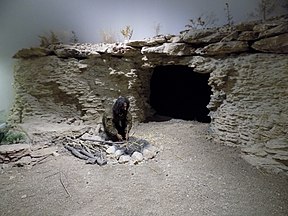Our website is made possible by displaying online advertisements to our visitors.
Please consider supporting us by disabling your ad blocker.
Epipalaeolithic Near East
Prehistoric Southwest Asia | ||
4000 — – 5000 — – 6000 — – 7000 — – 8000 — – 9000 — – 10000 — – 11000 — – 12000 — – 13000 — – 14000 — – 15000 — – 16000 — – 17000 — – 18000 — – 19000 — – 20000 — – 21000 — – 22000 — – 23000 — – 24000 — – 25000 — – 26000 — | ↓ Historic ↓ ↑ Palaeolithic ↑ | |
Axis scale is years Before Present | ||
The Epipalaeolithic Near East designates the Epipalaeolithic ("Final Old Stone Age", also known as Mesolithic) in the prehistory of the Near East. It is the period after the Upper Palaeolithic and before the Neolithic, between approximately 20,000 and 10,000 years Before Present (BP).[1][2] The people of the Epipalaeolithic were nomadic hunter-gatherers who generally lived in small, seasonal camps rather than permanent villages. They made sophisticated stone tools using microliths—small, finely-produced blades that were hafted in wooden implements. These are the primary artifacts by which archaeologists recognise and classify Epipalaeolithic sites.[3]
The start of the Epipalaeolithic is defined by the appearance of microliths.[2][4][5] Although this is an arbitrary boundary, the Epipalaeolithic does differ significantly from the preceding Upper Palaeolithic. Epipalaeolithic sites are more numerous, better preserved, and can be accurately radiocarbon dated. The period coincides with the gradual retreat of glacial climatic conditions between the Last Glacial Maximum and the start of the Holocene, and it is characterised by population growth and economic intensification.[2] The Epipalaeolithic ended with the "Neolithic Revolution" and the onset of domestication, food production, and sedentism, although archaeologists now recognise that these trends began in the Epipalaeolithic.[5][6]
The period may be subdivided into Early, Middle and Late Epipalaeolithic: The Early Epipalaeolithic corresponds to the Kebaran culture, c. 20,000 to 14,500 years ago, the Middle Epipalaeolithic is the Geometric Kebaran or late phase of the Kebaran, and the Late Epipalaeolithic to the Natufian, 14,500–11,500 BP.[7] The Natufian overlaps with the incipient Neolithic Revolution, the Pre-Pottery Neolithic A.
- ^ Simmons, 46
- ^ a b c Shea, John J. (2013). "The Epipalaeolithic". Stone Tools in the Paleolithic and Neolithic Near East. Cambridge: Cambridge University Press. pp. 161–212. doi:10.1017/cbo9781139026314.007. ISBN 9781139026314.
- ^ Simmons, 48-49
- ^ Bar-Yosef, Ofer (1994). "Western Asia from the end of the Middle Palaeolithic to the beginnings of food production". In de Laet, Siegfried J. (ed.). History of Humanity Volume 1: Prehistory and the Beginnings of Civilization. Paris / London: UNESCO / Routledge. pp. 241–255. ISBN 978-0415093057. OCLC 223951055.
- ^ a b Maher, Lisa A.; Richter, Tobias; Stock, Jay T. (2012). "The Pre-Natufian Epipaleolithic: Long-term Behavioral Trends in the Levant". Evolutionary Anthropology: Issues, News, and Reviews. 21 (2): 69–81. doi:10.1002/evan.21307. ISSN 1060-1538. PMID 22499441. S2CID 32252766.
- ^ Bar-Yosef, Ofer (1998). "The Natufian culture in the Levant, threshold to the origins of agriculture". Evolutionary Anthropology: Issues, News, and Reviews. 6 (5): 159–177. doi:10.1002/(sici)1520-6505(1998)6:5<159::aid-evan4>3.0.co;2-7. ISSN 1520-6505. S2CID 35814375.
- ^ Simmons, 47-48
Previous Page Next Page




